Main menu
Common skin conditions

NEWS
Join DermNet PRO
Read more
Quick links
Basal cell carcinoma dermoscopy — extra information
Lesions (cancerous) Diagnosis and testing
Basal cell carcinoma dermoscopy
Author: Naomi Ashman, Dermoscopist, Torbay Skin, Auckland, New Zealand; DermNet New Zealand Editor in Chief Adjunct A/Prof Amanda Oakley, Dermatologist, Hamilton, New Zealand. Copy edited by Gus Mitchell. Created 2019.
Introduction
Clinical features
Dermoscopic features
Differential diagnoses
Histology
What is basal cell carcinoma?
Basal cell carcinoma (BCC) is a common, locally invasive, keratinocytic, or nonmelanoma skin cancer. It is also known as rodent ulcer and basalioma. Patients with BCC often develop multiple primary tumours over time.
Basal cell carcinoma can be pigmented or nonpigmented. Its subtypes include:
- Nodular
- Superficial
- Morphoeic (also known as sclerosing and infiltrative)
- Other less common variants.
What are the clinical features of basal cell carcinoma?
The clinical features of basal cell carcinoma are:
- Slowly growing irregular nodule or plaque
- Skin coloured, pink, or pigmented
- Size varies from a few millimetres to several centimetres in diameter
- Spontaneous bleeding, erosion, or ulceration.
Clinical features of nodular basal cell carcinoma
Nodular basal cell carcinoma is the most common type of facial BCC. The clinical features of nodular basal cell carcinoma are:
- Shiny or pearly nodule with a smooth surface
- May have a central depression or ulceration, so its edges appear rolled
- Blood vessels crossing its surface
- The cystic variant is soft, with jelly-like contents.
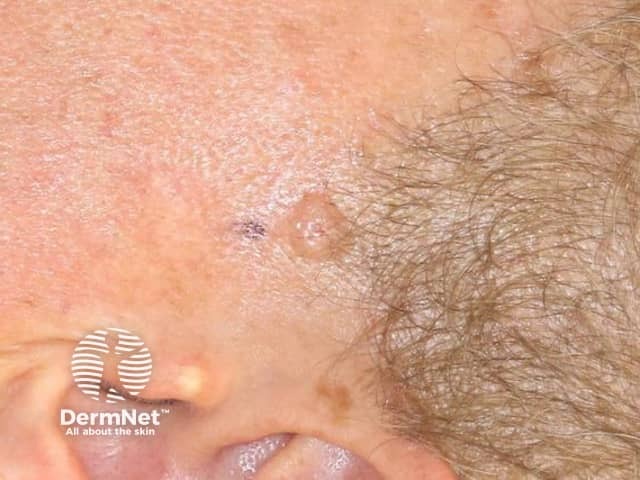
Nodular basal cell carcinoma
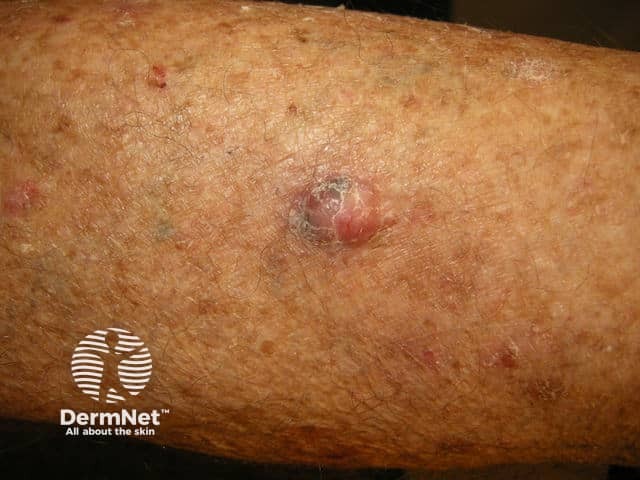
Nodular basal cell carcinoma, leg
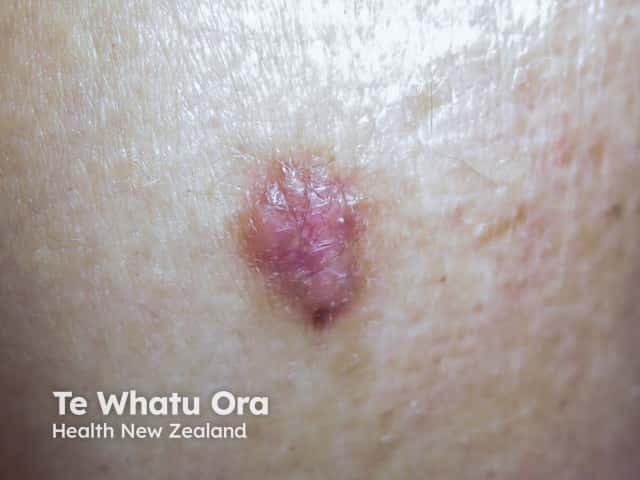
Nodular basal cell carcinoma, arm
Clinical features of superficial basal cell carcinoma
Superficial basal cell carcinoma is the most common type of BCC in younger adults and is the most common type on upper trunk and shoulders. The clinical features of superficial basal cell carcinoma are:
- Slightly scaly, irregular plaque
- Thin, translucent rolled border
- Multiple microerosions.
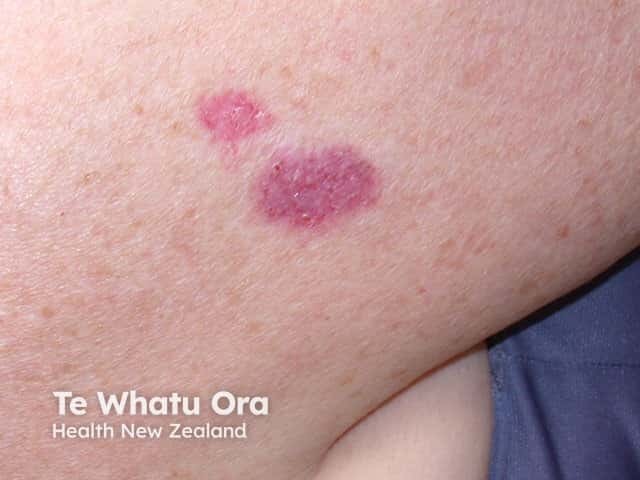
Superficial basal cell carcinoma, arm
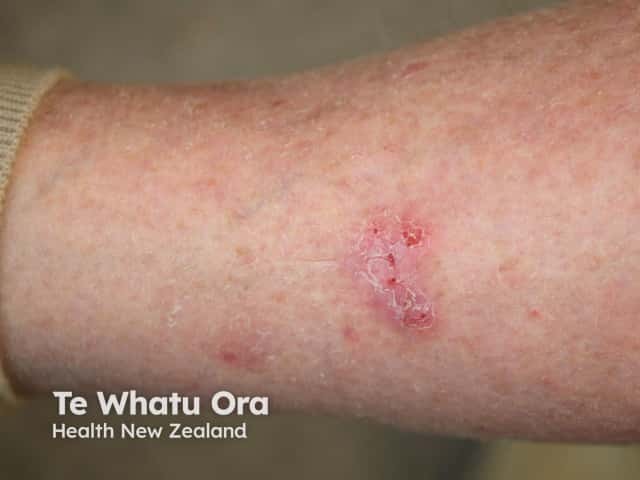
Superficial basal cell carcinoma, leg
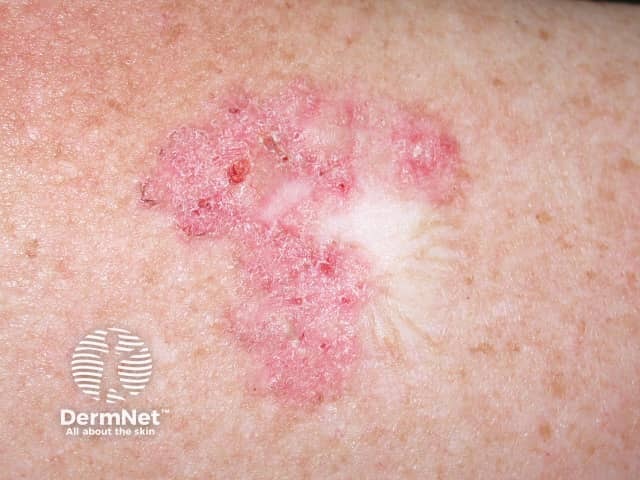
Superficial basal cell carcinoma, trunk
Clinical features of morphoeic basal cell carcinoma
Morphoeic basal cell carcinoma, also known as morpheic, morphoeiform, or sclerosing basal cell carcinoma, is usually found in midfacial sites. It can have wide and deep subclinical extensions and may infiltrate cutaneous nerves (perineural spread). It presents as an indistinct, waxy, scar-like plaque with ill-defined borders.
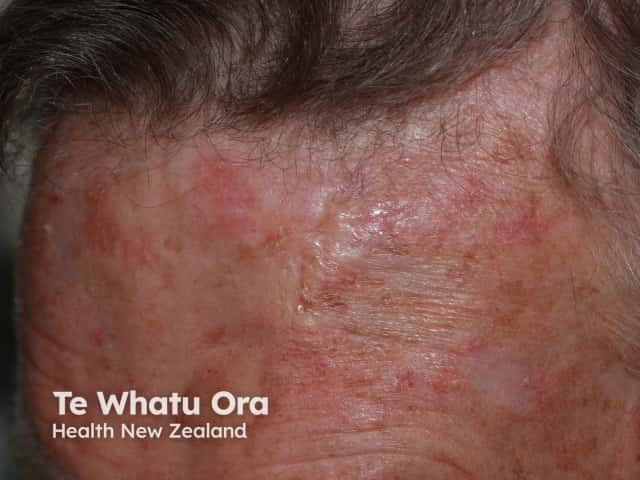
Morphoeic basal cell carcinoma
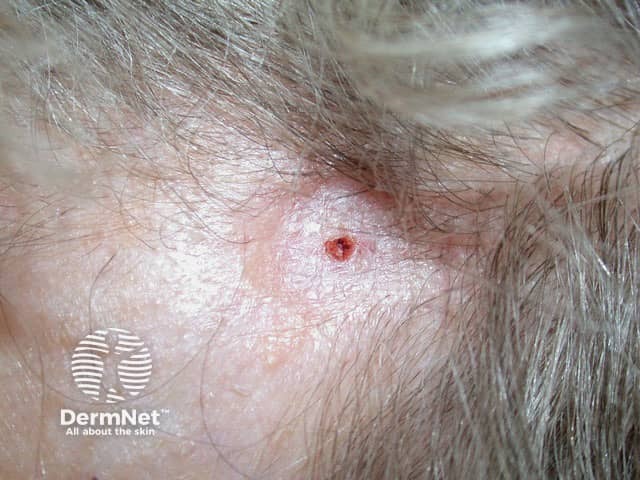
Morphoeic basal cell carcinoma
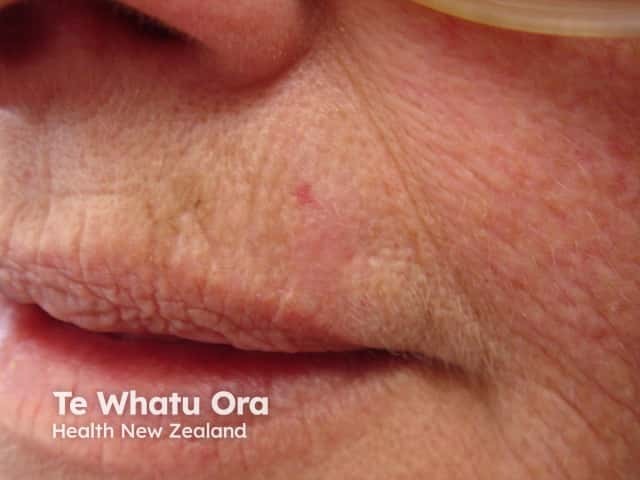
Morphoeic basal cell carcinoma
What are the dermoscopic features of basal cell carcinoma?
The dermoscopic features of basal cell carcinoma vary according to subtype.
Pigmented basal cell carcinoma
The dermoscopic features of pigmented basal cell carcinoma include:
- Absence of pigment network
- White, pink, grey, or light brown stroma
- Sharply defined, fine linear and branching serpentine vessels — these are also known as arborising vessels
- Structureless or leaf-like areas on the periphery of the lesion — these present as brown to grey-blue discrete bulbous blobs with pigment converging on a less-pigmented area
- Large blue-grey ovoid nests or blotches, also known as large clods
- Multiple blue-grey dots and clods
- Specks of brown and grey pigment (peppering, buckshot scattering)
- Concentric structures — dark central clod within a light brown larger clod
- Spoke wheel areas — these present as radial projections from a well-circumscribed dark central hub
- Short white lines or perpendicular white lines under polarised light only
- Focal ulceration
- Adherent fibre.
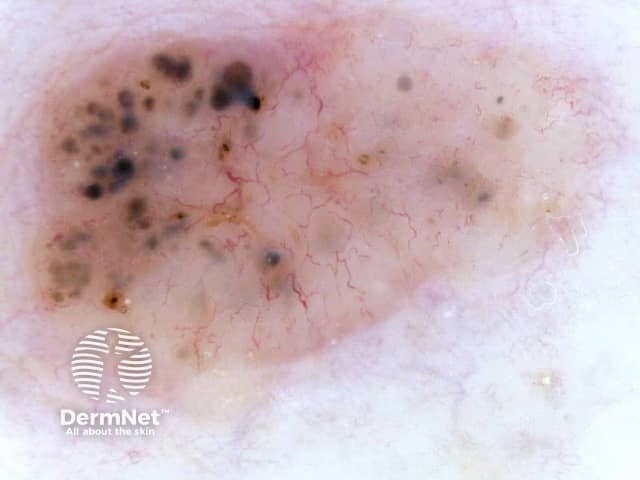
Branching serpentine vessels and blue-grey ovoid nests in pigmented basal cell carcinoma dermoscopy
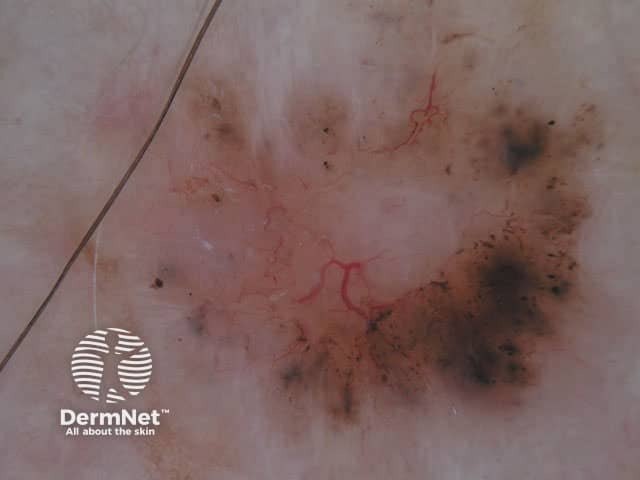
Branching serpentine vessels, leaf-like structures, blue-grey and brown dots in pigmented basal cell carcinoma dermoscopy
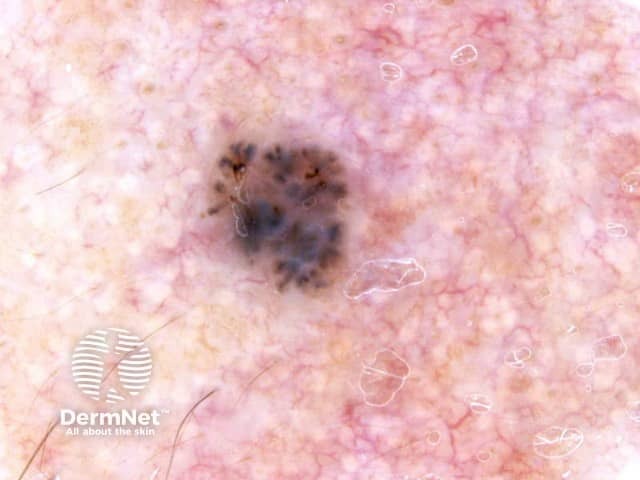
Leaf like areas in pigmented basal cell carcinoma dermoscopy
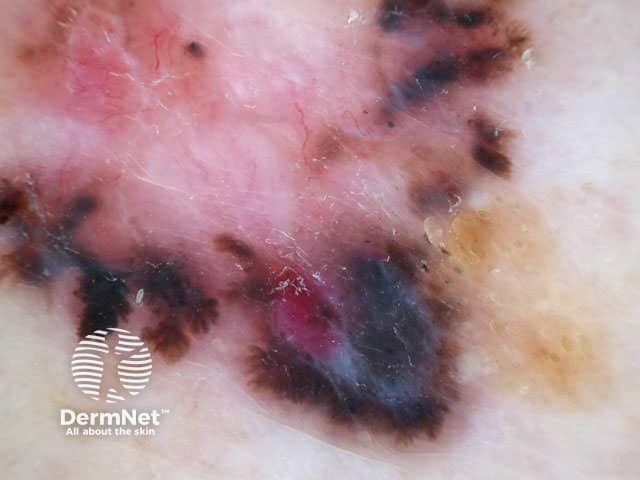
Leaf-like structures in pigmented basal cell carcinoma dermoscopy
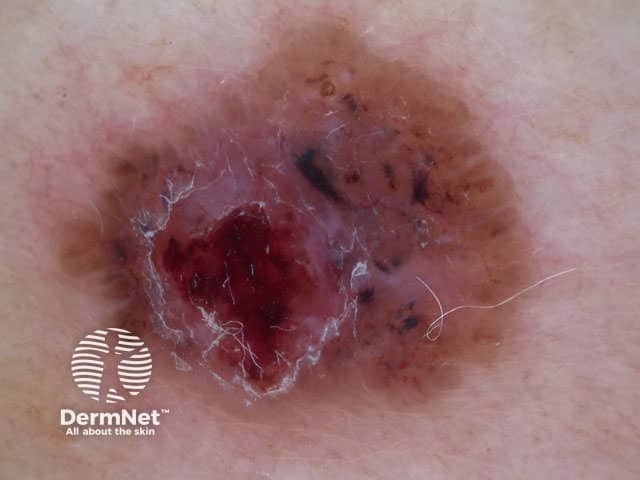
Adherent fibre, leaf-like structures and serpentine vessels in pigmented basal cell carcinoma dermoscopy
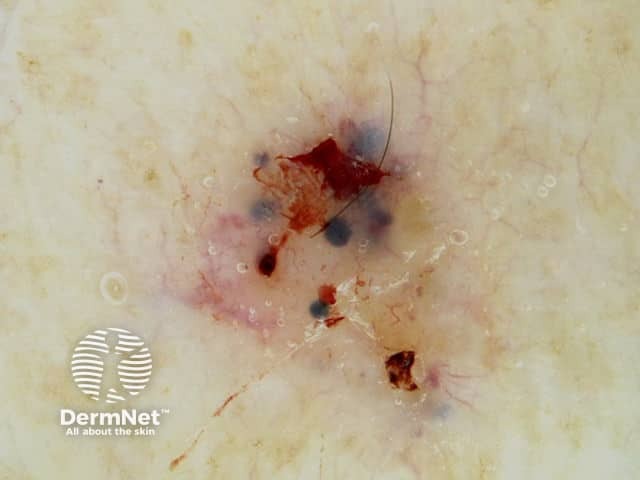
Blue-grey ovoid nests in pigmented basal cell carcinoma dermoscopy
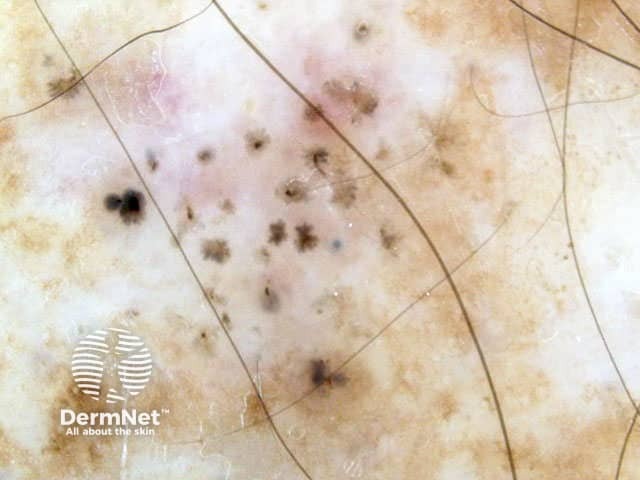
Spoke wheels in pigmented basal cell carcinoma dermoscopy
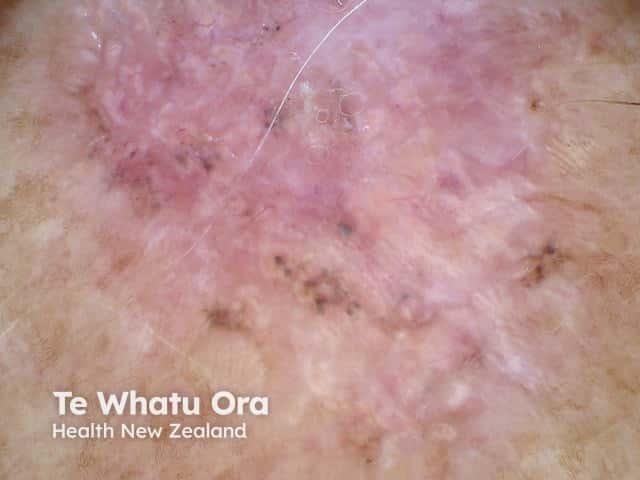
Perpendicular white lines, blue globule, leaf-like structures in pigmented basal cell carcinoma dermoscopy
Nonpigmented basal cell carcinoma
The dermoscopic features of nonpigmented basal cell carcinoma include:
- Bluish or whitish-pink stroma
- Asymmetrical branching serpentine (arborising) vessels
- Focal ulceration
- Slight scaling
- White clues, particularly perpendicular white lines (polarised light only) and structureless roundish white or yellowish areas.
On close inspection, some apparently non-pigmented basal cell carcinomas have a lightly pigmented stroma.
Nodular basal cell carcinomas lose the blue hue and instead may have a white rim around central ulceration. White clods (milia-like cysts may be present.
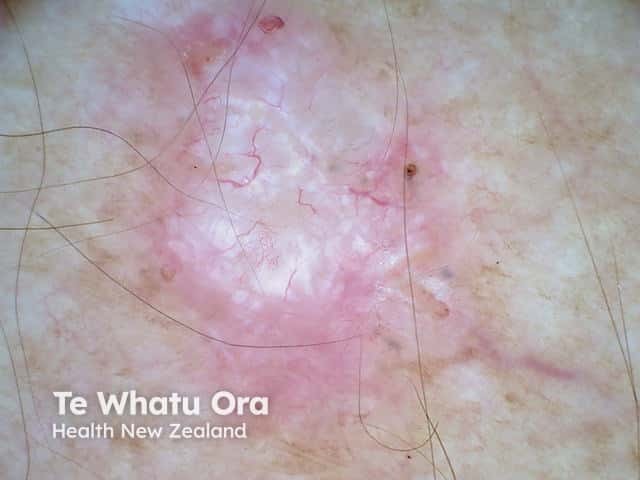
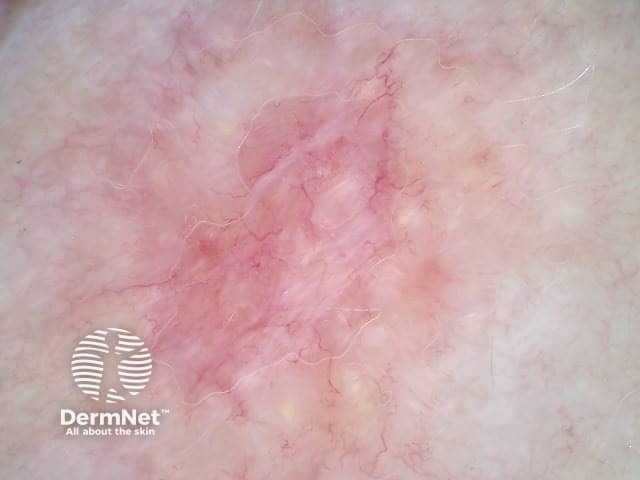
Cystic basal cell carcinoma (polarised view showing crystalline structures)
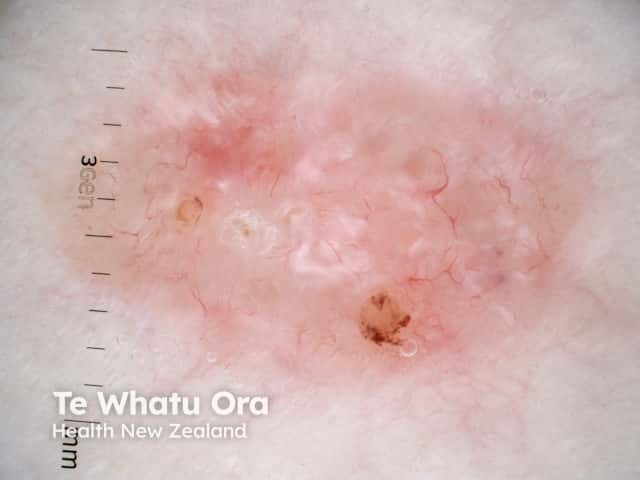
Dermoscopic features of nodular basal cell carcinoma
The dermoscopic features of nodular basal cell carcinoma include:
- Arborising vessels (branched red lines)
- Blue-grey ovoid nests (large clods)
- Ulceration
- Peppering (grey or brown dots) and or clods.
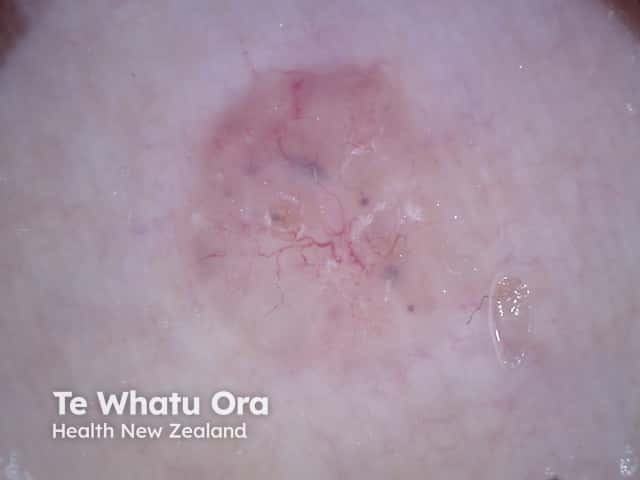
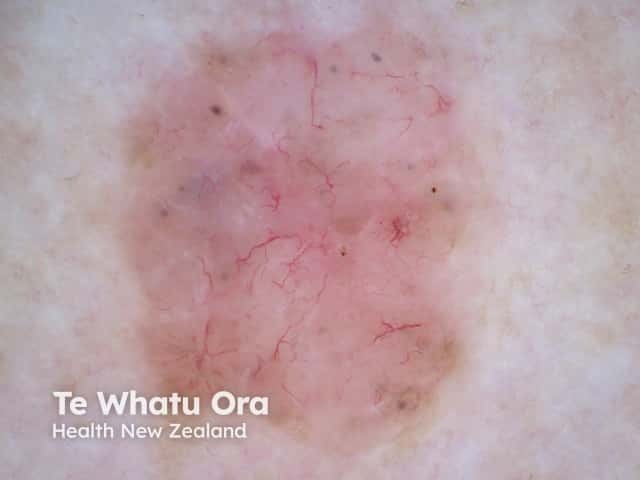
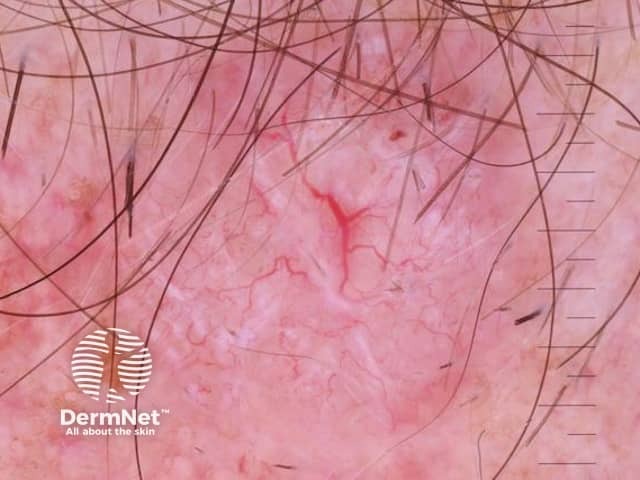
Nodular basal cell carcinoma dermoscopy
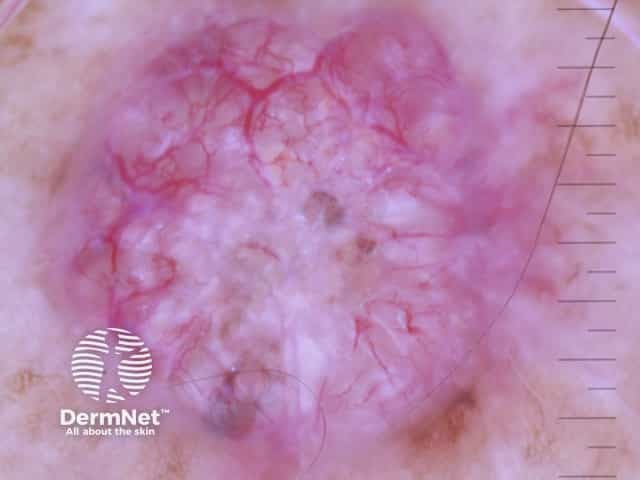
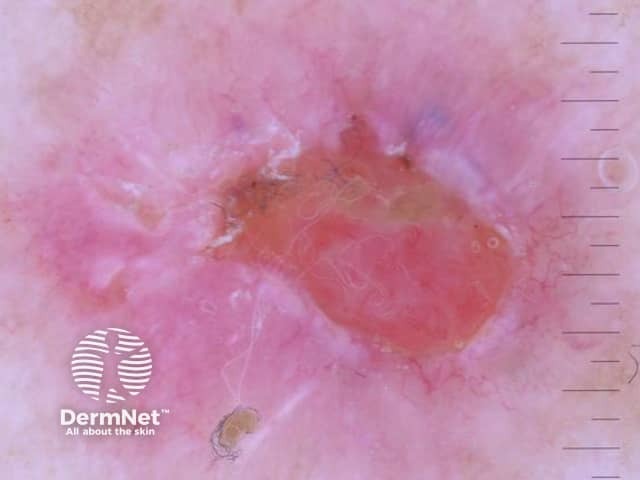
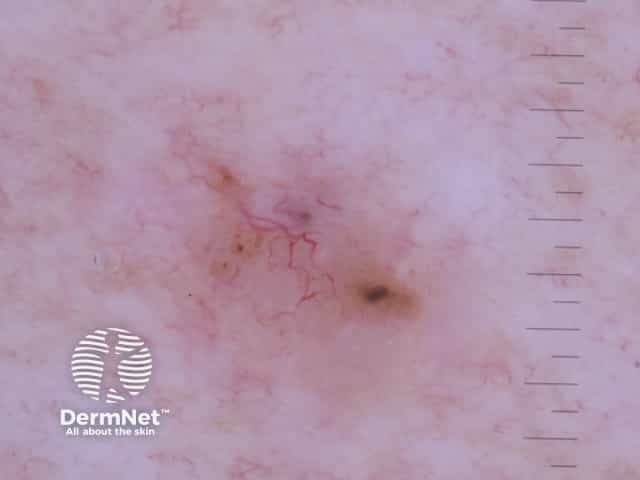
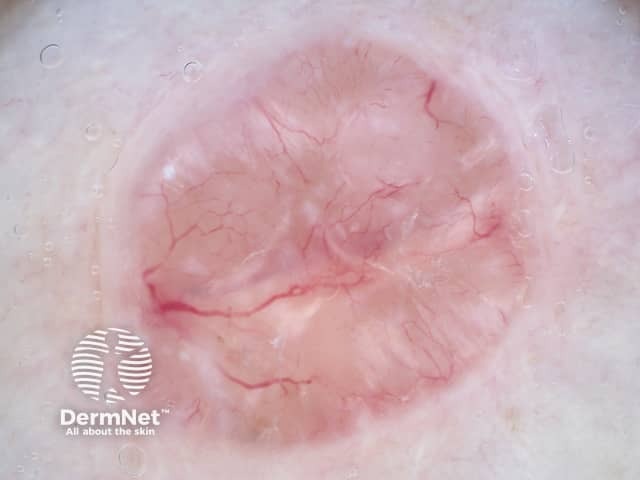
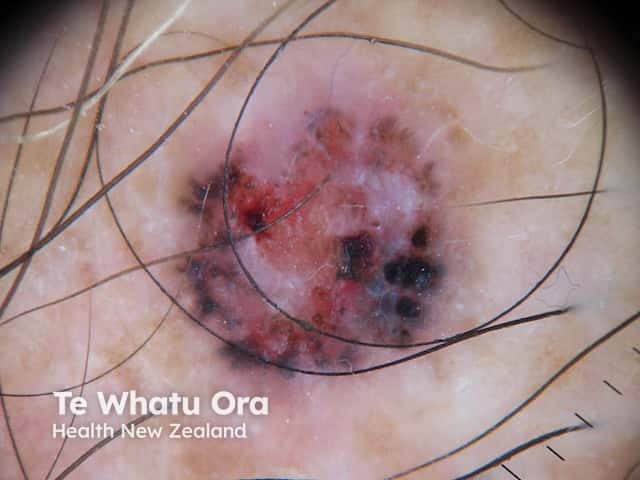
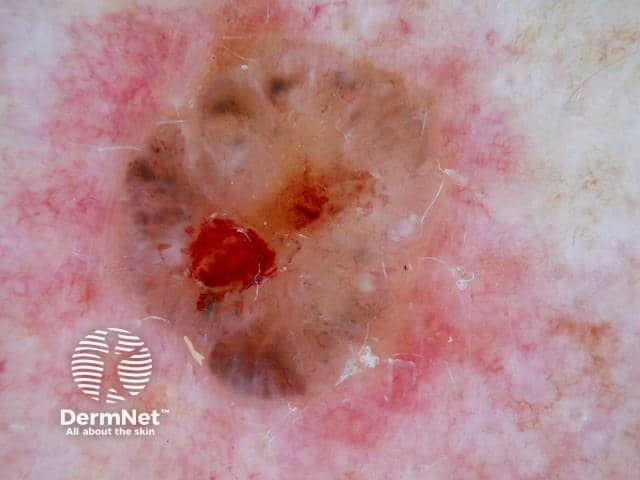
Dermoscopic features of superficial basal cell carcinoma
The dermoscopic features of superficial basal cell carcinoma include:
- Short fine telangiectases
- Perpendicular white lines (polarised light only)
- Ulceration and adherent fibre
- Leaf-like areas (brown to grey-blue discrete bulbous blobs that often form a pattern shaped like a leaf; they can sometimes appear as tan, broad, and fuzzy streaks at the periphery of a lesion)
- Absence of blue-grey ovoid nests, arborising vessels and ulceration
- Multiple small erosions
- White, red structureless areas (milky pink areas)
- Shiny white to red areas.
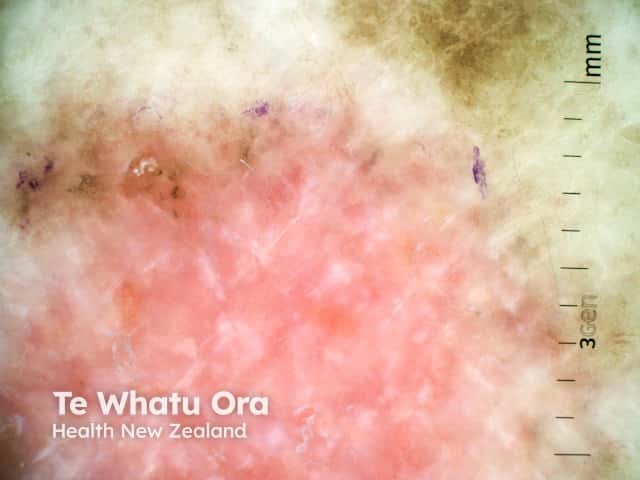
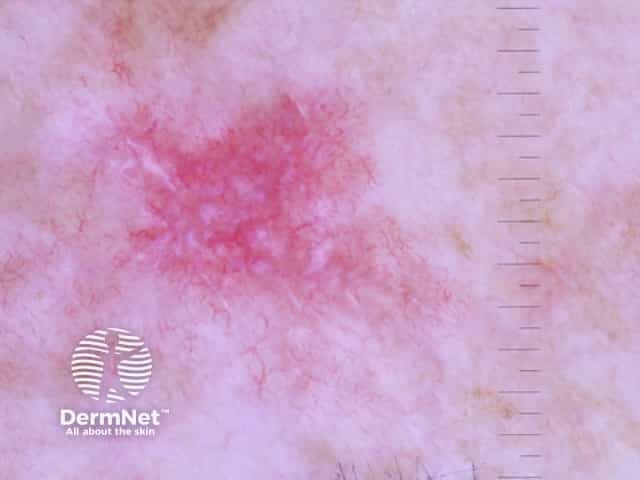
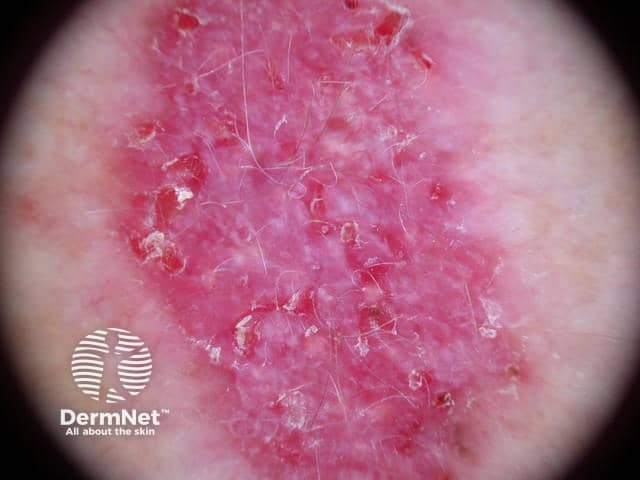
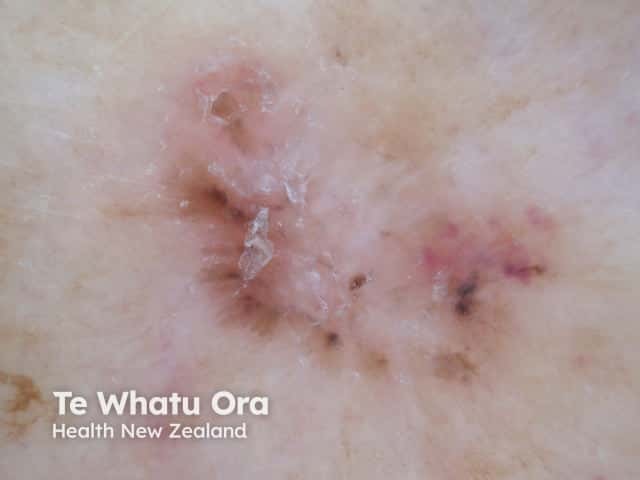
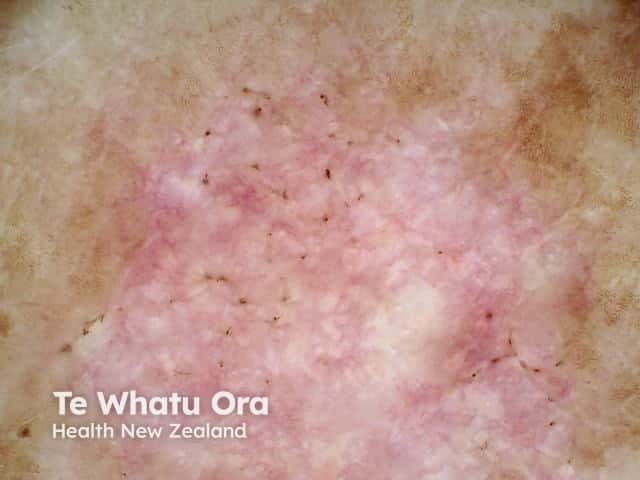
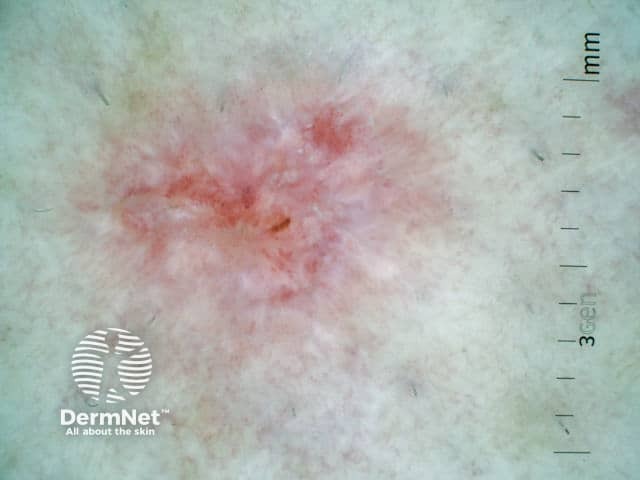
Dermoscopic features of morphoeic basal cell carcinoma
The dermoscopic features of morphoeic basal cell carcinoma include:
- A predominant white structureless scar-like area with a few fine branching serpentine vessels and multiple brown dots
- Sometimes vessels are the only clue.
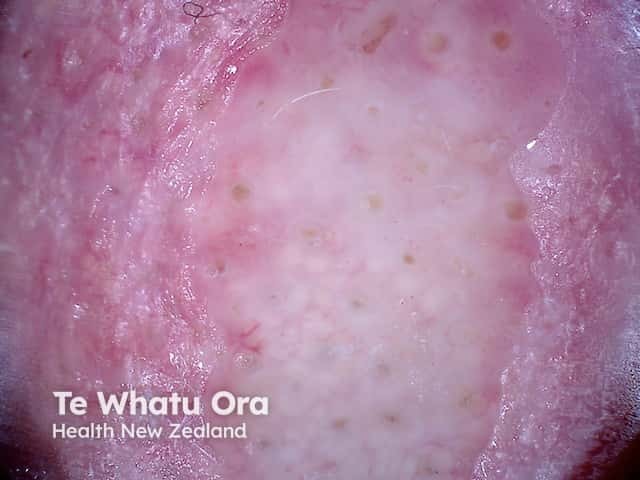
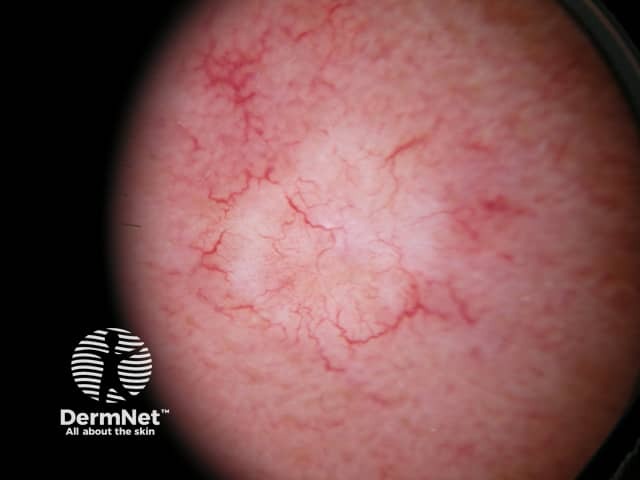
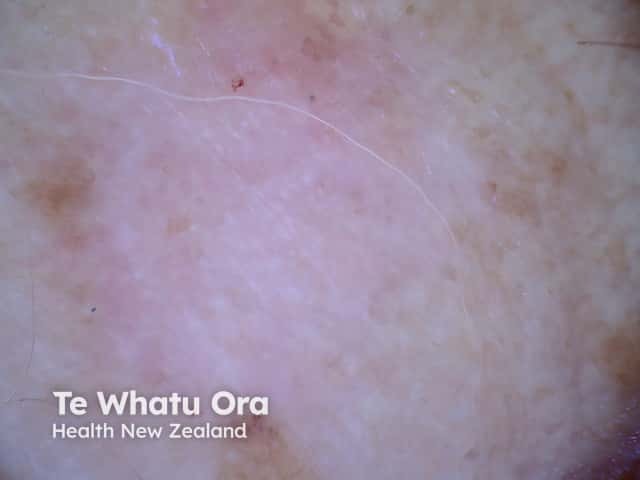
What is the dermoscopic differential diagnosis of basal cell carcinoma?
Differential diagnoses for basal cell carcinoma are:
- Sebaceous hyperplasia
- Melanoma
- Pilomatricoma
- Trichoepithelioma.
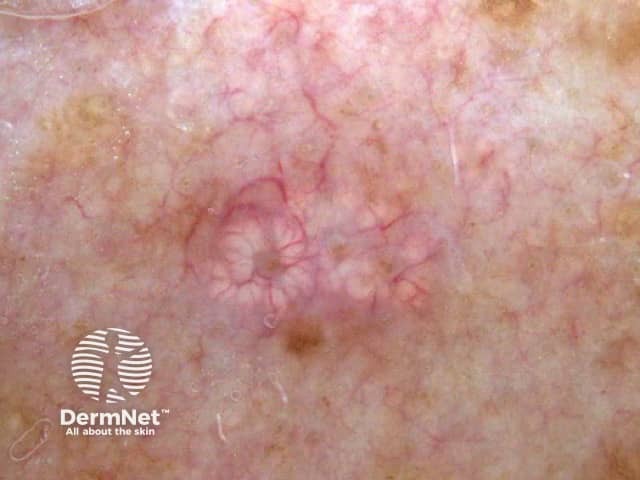
Sebaceous hyperplasia dermoscopy
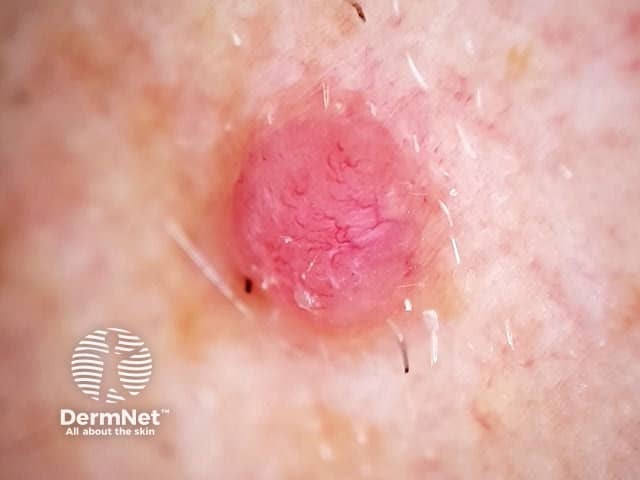
Amelanotic melanoma dermoscopy
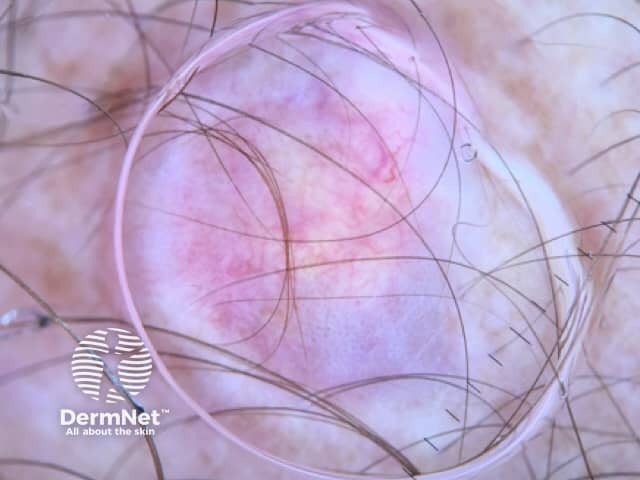
Pilomatricoma dermoscopy
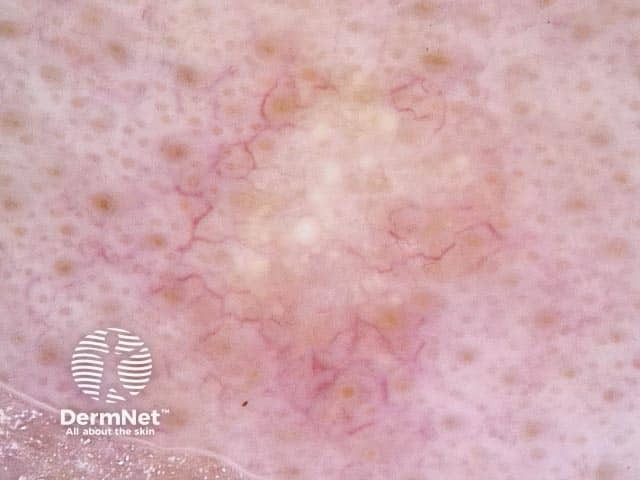
Dermoscopy of a benign trichoepithelioma - white clod-like structures are surrounded by telangiectatic vessels
What is the histological explanation of features of basal cell carcinoma?
Below are histological explanations for the features of basal cell carcinoma.
Sharply defined fine linear and branching serpentine vessels
Thickening of the epidermis causes dilated papillary dermal blood vessels (which usually appear as red dots) to be drawn out to form sharply defined fine linear and branching serpentine vessels. They sit close to the surface of the skin.
Leaf-like areas
Leaf-like areas are brown to grey-blue discrete bulbous blobs that form a pattern shaped like a leaf and are caused by nodules of pigmented basal cell carcinoma cells in the upper dermis.
Large blue ovoid nests
Large blue ovoid nests are also known as large blue clods and are created by nests of basal cell tumour in the dermis.
Multiple blue clods
Blue clods are formed by nests of basal cell tumour in the dermis.
Specks of brown and grey pigment
Specks of brown and grey pigment are formed as follows:
- Grey dots are due to melanin pigment within the papillary dermis, either free, in small nests of melanocytes or, more commonly, in melanophages
- Brown dots reflect either small nests of melanocytes in the basal epidermis, focal pigmented keratinocytic proliferation, as seen in some forearm solar lentigines or superficial dermal haemosiderin deposition.
Spoke wheel areas
Spoke wheel areas are also known as radial projections joined at a central hub and are formed by nests and proliferation of pigmented basal cell carcinoma cells.
Perpendicular white lines
Perpendicular white lines are thought to be caused by fibrous tissue.
References
- Malvehy J, Puig S, Braun RP, Marghoob AA, Kopf AW. Handbook of dermoscopy. London: Informa Healthcare, 2011.
- Menzies SW. Dermoscopy of pigmented basal cell carcinoma. Clin Dermatol. 2002 May-Jun;20(3):268–9. PubMed
- Menzies SW, Westerhoff K, Rabinovitz H, Kopf AW, McCarthy WH, Katz B. Surface microscopy of pigmented basal cell carcinoma. Arch Dermatol. 2000 Aug;136(8):1012–6. PubMed
- Kreusch JF. Vascular patterns in skin tumors. Clin Dermatol. 2002 May-Jun;20(3):248–54. PubMed
- Kittler H, Rosendahl C, Cameron A, Tschandl P; Dermoscopy Pattern analysis of pigmented and non-pigmented lesions; 2nd ed. 2016, Vienna, Austria.
- Superficial basal cell carcinoma. Dermoscopedia. Available at: https://dermoscopedia.org/Superficial_Basal_cell_carcinoma (accessed 23 April 2019).
- Lallas A, Apalla Z, Argenziano G, Longo C, Moscarella E, Specchio F, Raucci M, Zalaudek I. The dermatoscopic universe of basal cell carcinoma. Dermatol Pract Concept. 2014;4(3):2. PubMed Central
- Wozniak-Rito A, Zalaudek I, Rudnicka L. Dermoscopy of basal cell carcinoma. Clin Exp Dermatol. 2018 Apr;43(3):241–7. doi: 10.1111/ced.13387. Epub 2018 Jan 17. Review. PubMed
- Bengü Nisa Akay, MD, Cengizhan Erdem, MD; The Evaluation of Dermoscopic Findings in Basal Cell Carcinoma; University of Ankara, School of Medicine, Department of Dermatology, Turkey; Published: J Turk Acad Dermatol 2010;4(3):04301a. Journal
- Braun RP. Leaf like areas. Dermoscopedia. Available at: https://dermoscopedia.org/Leaf_like_areas (accessed 23 April 2019).
